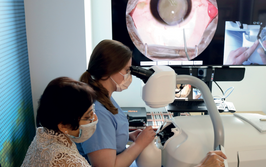Also in the News…
The Ophthalmologist brings you the top news stories and studies of the week
Alun Evans | | 3 min read | News

From seaweed being used to create an artificial vitreous body replacement for retinal detachment, to the new drug combination developed to treat previously multidrug-resistant (MDR) strains of bacterial keratitis, these are the trailblazing studies that caught our attention this week…
Retinal seaweed. A new South Korean study has proposed an innovative method for treating retinal detachment. To replace the vitreous body of the eye, the team behind the study – which included ophthalmologists, chemical engineers, and pathologists – created an artificial hydrogel based on alginate, a viscous carbohydrate naturally occurring in seaweed. They concluded that the artificial substitute could serve as a possible vitreous replacement for real-world retinal detachment care. Link
Zika mechanisms. A new iScience study has identified several molecular mechanisms underlying the ocular abnormalities caused by the Zika virus, which include optic neuritis, hypoplasia of the optic nerve, and hemorrhagic retinopathy. The team aims to apply these mechanisms to identify potential targets for therapeutic intervention. Link
Critical flicker. The rate of visual perception in humans varies widely, according to new evidence found in a study conducted by Trinity College Dublin. To measure this visual perception speed (or “temporal resolution”), researchers used the critical flicker fusion threshold – a measure aimed at determining the maximum frequency someone can determine that a light source is flickering (as opposed to fusing into one constant light source). Link
Treating bacterial keratitis. In a recent Cornea study, researchers showed that a novel drug combination – polymyxin B/trimethoprim (PT) + rifampin – is effective in eliminating several pathogens associated with bacterial keratitis, eliminating all 43 of the isolates tested, including those isolates previously determined as MDR (multidrug-resistant). The authors are hopeful that further research might point to the combination as the potential gold standard treatment for bacterial keratitis. Link
Coming from a creative writing background, I have a great interest in fusing original, narrative-driven concepts with informative, educational content. Working at The Ophthalmologist allows me to connect with the great minds working in the field of contemporary eye care, and explore the human element involved in their scientific breakthroughs.













